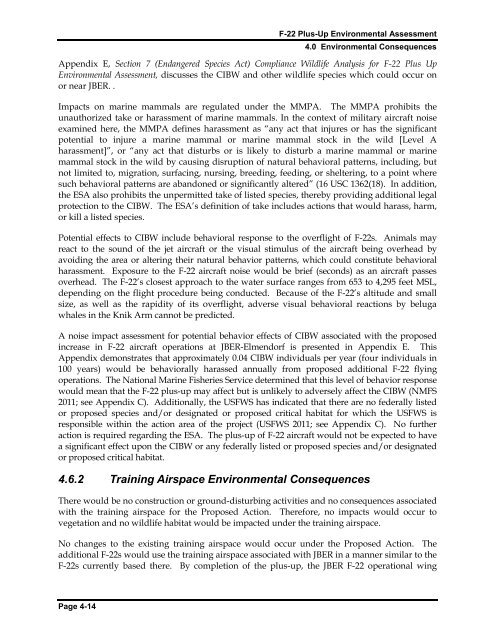F-22 Plus-Up Environmental Assessment - Joint Base Elmendorf ...
F-22 Plus-Up Environmental Assessment - Joint Base Elmendorf ...
F-22 Plus-Up Environmental Assessment - Joint Base Elmendorf ...
You also want an ePaper? Increase the reach of your titles
YUMPU automatically turns print PDFs into web optimized ePapers that Google loves.
F-<strong>22</strong> <strong>Plus</strong>-<strong>Up</strong> <strong>Environmental</strong> <strong>Assessment</strong><br />
4.0 <strong>Environmental</strong> Consequences<br />
Appendix E, Section 7 (Endangered Species Act) Compliance Wildlife Analysis for F-<strong>22</strong> <strong>Plus</strong> <strong>Up</strong><br />
<strong>Environmental</strong> <strong>Assessment</strong>, discusses the CIBW and other wildlife species which could occur on<br />
or near JBER. .<br />
Impacts on marine mammals are regulated under the MMPA. The MMPA prohibits the<br />
unauthorized take or harassment of marine mammals. In the context of military aircraft noise<br />
examined here, the MMPA defines harassment as “any act that injures or has the significant<br />
potential to injure a marine mammal or marine mammal stock in the wild [Level A<br />
harassment]”, or “any act that disturbs or is likely to disturb a marine mammal or marine<br />
mammal stock in the wild by causing disruption of natural behavioral patterns, including, but<br />
not limited to, migration, surfacing, nursing, breeding, feeding, or sheltering, to a point where<br />
such behavioral patterns are abandoned or significantly altered” (16 USC 1362(18). In addition,<br />
the ESA also prohibits the unpermitted take of listed species, thereby providing additional legal<br />
protection to the CIBW. The ESA’s definition of take includes actions that would harass, harm,<br />
or kill a listed species.<br />
Potential effects to CIBW include behavioral response to the overflight of F-<strong>22</strong>s. Animals may<br />
react to the sound of the jet aircraft or the visual stimulus of the aircraft being overhead by<br />
avoiding the area or altering their natural behavior patterns, which could constitute behavioral<br />
harassment. Exposure to the F-<strong>22</strong> aircraft noise would be brief (seconds) as an aircraft passes<br />
overhead. The F-<strong>22</strong>’s closest approach to the water surface ranges from 653 to 4,295 feet MSL,<br />
depending on the flight procedure being conducted. Because of the F-<strong>22</strong>’s altitude and small<br />
size, as well as the rapidity of its overflight, adverse visual behavioral reactions by beluga<br />
whales in the Knik Arm cannot be predicted.<br />
A noise impact assessment for potential behavior effects of CIBW associated with the proposed<br />
increase in F-<strong>22</strong> aircraft operations at JBER-<strong>Elmendorf</strong> is presented in Appendix E. This<br />
Appendix demonstrates that approximately 0.04 CIBW individuals per year (four individuals in<br />
100 years) would be behaviorally harassed annually from proposed additional F-<strong>22</strong> flying<br />
operations. The National Marine Fisheries Service determined that this level of behavior response<br />
would mean that the F-<strong>22</strong> plus-up may affect but is unlikely to adversely affect the CIBW (NMFS<br />
2011; see Appendix C). Additionally, the USFWS has indicated that there are no federally listed<br />
or proposed species and/or designated or proposed critical habitat for which the USFWS is<br />
responsible within the action area of the project (USFWS 2011; see Appendix C). No further<br />
action is required regarding the ESA. The plus-up of F-<strong>22</strong> aircraft would not be expected to have<br />
a significant effect upon the CIBW or any federally listed or proposed species and/or designated<br />
or proposed critical habitat.<br />
4.6.2 Training Airspace <strong>Environmental</strong> Consequences<br />
There would be no construction or ground-disturbing activities and no consequences associated<br />
with the training airspace for the Proposed Action. Therefore, no impacts would occur to<br />
vegetation and no wildlife habitat would be impacted under the training airspace.<br />
No changes to the existing training airspace would occur under the Proposed Action. The<br />
additional F-<strong>22</strong>s would use the training airspace associated with JBER in a manner similar to the<br />
F-<strong>22</strong>s currently based there. By completion of the plus-up, the JBER F-<strong>22</strong> operational wing<br />
Page 4-14
















